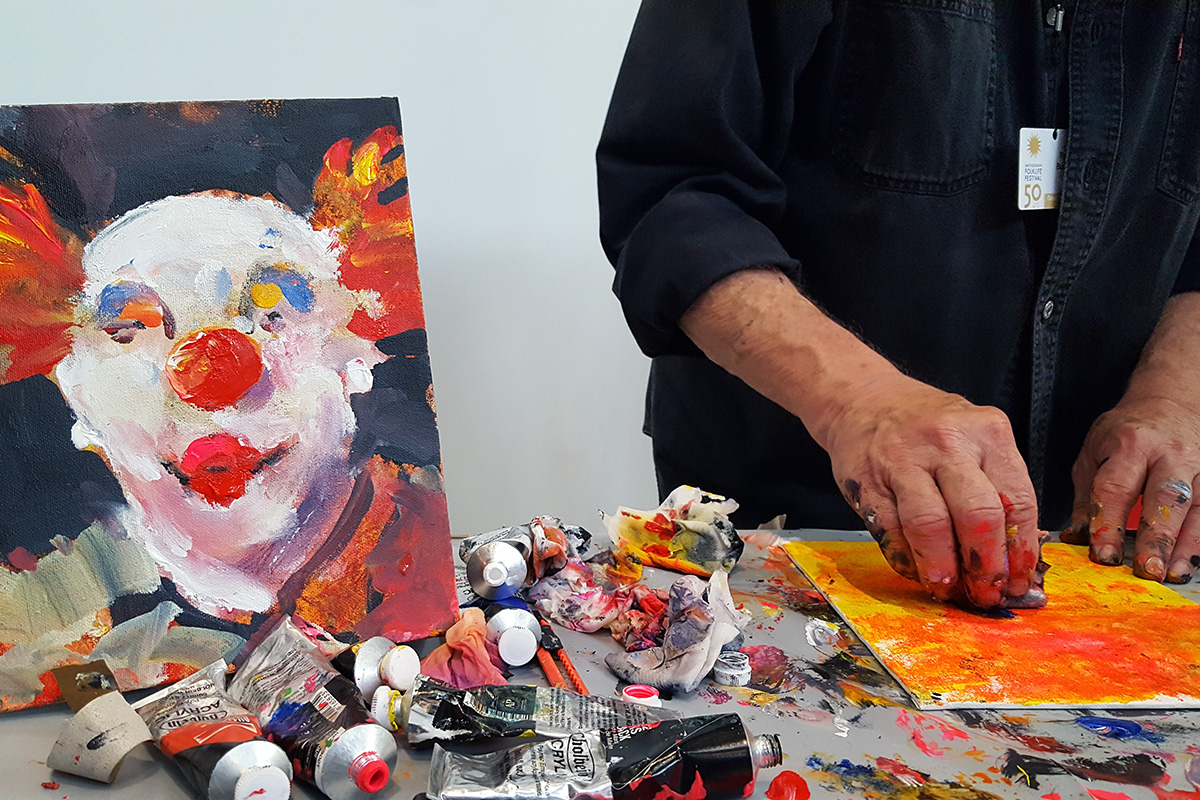Painting the Circus in Pink: A Q&A with Robert Burridge

It starts with a psychedelic patchwork of yellows and pinks. From there, broad strokes with a wadded paper towel form abstract shapes of white and black. A paint-stained fingertip details the glint of an eye, the shine of a big red nose. I turn away for a moment to watch an aerialist in the Arts and Industries Rotunda, and by the time I’ve turned back, a clown has emerged.
This is the work of Robert Burridge, a professional and very prolific painter—during his hour-long demonstration in the Festival Marketplace for the Circus Arts program, he created four scenes full of character and light. Based in Arroyo Grande, California, I know him best for his bright landscapes of the central coast, but he also considers himself an aficionado of the circus.
After finishing his session and shaking hands with friends and fans, Burridge answered a few questions in the Circus School backstage area, among the clamor of juggling and acrobatics rehearsals.
What about the circus inspires you and your art?
When I was a little boy, quite young, I loved circus performing so much. My dad would come and take me out of school to go down to watch the Ringling Bros. circus tents being put up. I remember going there and spending the whole day just watching the circus come together.
I love acrobatics so much so, and I was somewhat of a gymnast, that I put on performances on weekends for the neighborhood kids. My dad built me a trapeze for the backyard. I would do circus acts, magic shows, balancing acts, and juggling—just me! I had a major speech impediment when I was a kid, so I was pretty shy, introverted. This was my way of showing that I was somebody as a performer.
I still love the circus. If there’s one in town, I’ll know where it is—I can smell the animals. I take days off just to hang out with circus people. Every time I’m in Sarasota, Florida, to teach at the art center, I always give myself two days to be at the Ringling Museum.
They say you paint things better when they’re closer to your heart, and this whole history is close to my heart. It reminds me of my youth and doing these shows.

Where do circus and painting overlap?
Both are performing—only with painting there’s no net! There’s no applause, but I do have a recording. I hit the applause button once in a while when I finish a painting, just to make it fun. And it should be fun! Painting is fun, and circus is always about fun and entertainment.
It’s colorful, it’s surprising, it’s entertaining. To me the circus and the kind of paintings I do are the same. It’s a lifestyle—and it’s still dangerous. Sometimes you can work hours and days and still end with a pretty crumby show. That’s show business.
I do a lot of workshops all over the world, but I’m just teaching self-esteem, not really how to paint an apple. If I can build self-esteem for people, they know they can do anything. It’s like these schools for young kids, self-esteem schools for trapeze. It’s the same thing. But I’m doing it mostly with adults who never went through this great experience when they were young. They were always told what to do and how to paint.
The man who designs costumes for Cirque du Soleil, RuBen Permel, takes my private workshops to learn my color wheel. I’m so proud about that because when you go to Cirque du Soleil you see my color wheel! That’s another one of those best kept secrets I’ve never told anybody.
Do you paint circus characters from photos?
I make them all up. I don’t sit there and draw the exact famous clowns, Lou Jacobs or Emmett Kelly or anything like that. I practice every day, just like performers. Eventually when I go to do much bigger pieces, I already have those images in my brain. It’s kind of like muscle memory. I keep painting until I see something that makes me laugh, and then I stop.

What is your favorite circus memory?
I grew up in Harrisburg, Pennsylvania, and at that time it was the Clyde Beatty Cole Bros. Circus. I remember going and watching the Wallendas back in 1950, when it was Karl, the father, and the whole family. As a little kid, watching them do the pyramid on the high-wire, I was hooked! It was a thrill for me to see their act a few months ago in Sarasota.
This Folklife Festival was the highest moment for me in my painting art career and my love for the circus, to actually be here in the Smithsonian—showing my paintings, being amongst real circus people, being backstage watching all the young kids practicing. It gives me great hope for the future of the next generation of kids.
Elisa Hough is the editor for the Center for Folklife and Cultural Heritage. Meeting Robert Burridge was a special treat; her family used to vacation in Central California so that her mom could take his painting workshops.

